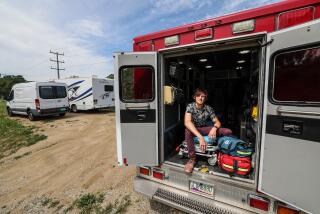Wider Use of Vans Pushed as Option to L.B. Ambulances
- Share via
LONG BEACH — A city councilman is pushing for wider use of vans as an alternative to ambulances as a way of cutting costs in transporting patients in non-emergency cases.
Despite opposition from several ambulance firms, Councilman Warren Harwood said he will ask the City Council on Tuesday to consider expanding the use of vehicles called gurney vans in place of fully equipped ambulances for patients not requiring emergency transportation.
“I think what we have now is a case where people who don’t have cash for ambulance transportation sometimes lay at home and die,” Harwood said in an interview.
Study Considered
The council will consider asking the city health board to study gurney vans, which supporters say would reduce by half the fee for transporting patients.
While the cost of emergency ambulance service runs as high as $250, a gurney van can make the same trip for $105, according to a report from the city manager’s office. A patient covered by private health insurance would pay $50 for ambulance service, while the rate for a gurney van would be $21, the report said.
Harwood said the saving is significant, especially for the city’s large elderly population. His push for the gurney van service comes after a council decision Tuesday to reject a firm’s effort to use the vehicles on a widespread basis in the city.
Although the council voted 5-1--with Harwood the lone opponent--to allow Medi-Ride Inc. to operate in the city, it restricted its use of gurney vans to patients using county health facilities.
Used for Special Patients The vans typically are used for patients who need hospitalization for treatment such as dialysis, chemotherapy or radiation.
Harwood said he felt some ambulance companies that had opposed Medi-Ride’s efforts to introduce gurney van service in the city had done “a snow job” on his council colleagues.
“I think that’s where a lot of their profit is--in non-emergency transportation,” Harwood said.
Ambulance operators have expressed concern that patients with serious illnesses might opt for a gurney van to save money when they really need an ambulance outfitted with sophisticated lifesaving equipment.
While emergency ambulances are operated by trained medical technicians and contain diagnostic and life-support equipment, gurney vans have no such equipment and drivers are required to have training only in cardiopulmonary resuscitation, ambulance operators said.
Ambulance firm officials said they are worried that increased competition for non-emergency services could lead to skyrocketing rates for emergency ambulances and decreased availability of those services.
“Our primary objection revolves around the fact that it would be using a lesser level of service with vehicles that don’t meet federal specifications for medical transportation,” said Stuart Stern, manager of Goodhew Ambulance Service.
Stern said the use of gurney vans could prompt a reduction in the number of fully-equipped ambulances. That could cause problems in the event of a mass-casualty disaster requiring the use of numerous emergency vehicles, he said.
“There is an economic issue, but that issue could have an impact on the other aspects of the service,” he said.
The city staff report indicated no great need for gurney vans in Long Beach. In Los Angeles, where gurney vans are allowed, an average of 34 patients a day are transported by the vehicles and 350 patients transported by wheelchair vans.
But Harwood said he feels there would be a demand for the gurney vans and other less-expensive medical transport.
“Why are all the ambulance companies opposing it if there’s no need?” he said. ‘If that’s the case, let some company provide the service and go broke. I would suggest that the need is substantial.”
Pete Ide, a member of the Long Beach Board of Health, agreed. “The elderly population in Long Beach that would use this kind of service is tremendous,” Ide said. “I think there are numerous incidences when a gurney would be fine.”
Ide said the ambulance firms oppose the use of gurney vans because of economics. “They’re against it because they’ll lose some business,” Ide said. “People have no choice as of now.”
More to Read
Sign up for Essential California
The most important California stories and recommendations in your inbox every morning.
You may occasionally receive promotional content from the Los Angeles Times.

![Los Angeles, CA - May 19: Carlos Vargas, left, and Paulina Rubio, members of the harm reduction team from Homeless Outreach Program Integrated Care Systems [HOPICS], a leading homeless services and housing agency, look for drug addicts to help and pass out supplies at a homeless RV encampment along 77th St. in South Los Angeles Friday, May 19, 2023. The team hands out syringes, fentanyl test strips, overdose reversal nose spray and medication to prevent overdoses, infection and disease transmission, including the HIV virus. Fenanyl is particularly insidious because it can be found in all other drugs, especially meth and heroin. The handouts are also meant to reduce infection through broken pipes, which can cut users mouths and open them to infection. . (Allen J. Schaben / Los Angeles Times)](https://ca-times.brightspotcdn.com/dims4/default/530e2db/2147483647/strip/true/crop/3900x2608+0+34/resize/320x214!/quality/75/?url=https%3A%2F%2Fcalifornia-times-brightspot.s3.amazonaws.com%2Fe9%2F77%2F4b8bd35d4881a3edec6b945b143b%2F1298639-me-soaring-fentanyl-deaths-24-1-ajs.jpg)











